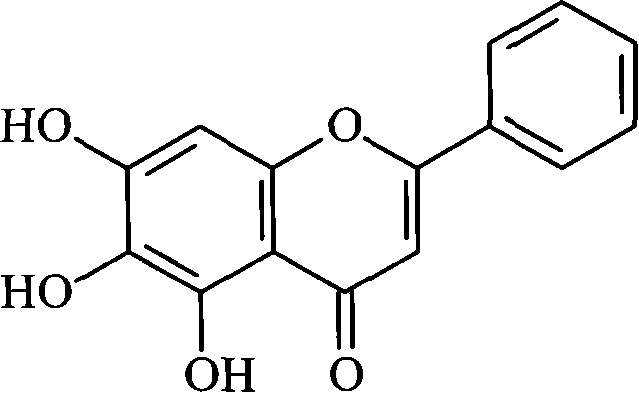Application of 5,6,7-trihydroxy flavone in the preparing of medicine for restraining bacterium
A trihydroxyflavonoid and antibacterial technology, applied in the field of microorganisms, can solve problems that do not involve the inhibition mechanism of the quorum sensing system
- Summary
- Abstract
- Description
- Claims
- Application Information
AI Technical Summary
Problems solved by technology
Method used
Image
Examples
Embodiment 1
[0031] Example 1: Virtual screening experiment of molecular docking software DOCK
[0032] PDB introduction: PDB is a free protein-related database, the web link is: http: / / www.pdb.org / pdb / home / home.do .
[0033] Introduction of TraR protein: TraR protein belongs to the LuxR family protein and is the receptor protein of the quorum sensing system of Agrobacterium. When it binds to its signaling molecule (3-oxo-c8-HSL), it will change its own conformation. Become a transcriptional activator of quorum sensing-related genes and promote the expression of related genes.
[0034] Molecular docking software DOCK: DOCK software is a molecular docking software developed by the research group of Professor Kuntz, Department of Pharmaceutical Chemistry, University of California, San Francisco. The principle of the software is to dock the compound in the database with the active site of the receptor to obtain a complex with electrostatic force and stereoscopic factors. The best way to re...
Embodiment 2
[0038] Embodiment two: 5,6,7-trihydroxyflavone inhibits the experiment of Pseudomonas aeruginosa biofilm formation
[0039] Add 975 μl of overnight cultured Pseudomonas aeruginosa bacteria solution, 25 μl of 40% glycerol, and 1 μl of 200 mM 5,6,7-trihydroxyflavone into a 2 ml plastic centrifuge tube. The treatment without 5,6,7-trihydroxyflavone was used as negative control. Cultured at 37°C for 3 days. Carefully pour off the liquid in the centrifuge tube, and gently rinse the centrifuge tube several times with sterilized distilled water to ensure that free bacteria in the centrifuge tube are washed away. After the water droplets on the inner wall of the centrifuge tube evaporate, add 1ml of 0.5% crystal violet solution and let stand at room temperature for 30 minutes. Pour off the crystal violet, and gently rinse the centrifuge tube several times with sterilized distilled water to ensure that the crystal violet not adsorbed on the biofilm is washed away. After the water dr...
Embodiment 3
[0041] Example three: 5,6,7-trihydroxyflavone inhibits Vibrio harveyi biofilm formation experiment
[0042] Add 975 μl of overnight-cultured Vibrio harvelii liquid, 25 μl of 40% glycerol, and 1 μl of 200 mM 5,6,7-trihydroxyflavone into a 2 ml plastic centrifuge tube. The treatment without 5,6,7-trihydroxyflavone was used as negative control. Cultured at 37°C for 3 days. Carefully pour off the liquid in the centrifuge tube, and gently rinse the centrifuge tube several times with sterilized distilled water to ensure that free bacteria in the centrifuge tube are washed away. After the water droplets on the inner wall of the centrifuge tube evaporate, add 1ml of 0.5% crystal violet solution and let stand at room temperature for 30 minutes. Pour off the crystal violet, and gently rinse the centrifuge tube several times with sterilized distilled water to ensure that the crystal violet not adsorbed on the biofilm is washed away. After the water droplets on the inner wall of the ce...
PUM
 Login to View More
Login to View More Abstract
Description
Claims
Application Information
 Login to View More
Login to View More - R&D
- Intellectual Property
- Life Sciences
- Materials
- Tech Scout
- Unparalleled Data Quality
- Higher Quality Content
- 60% Fewer Hallucinations
Browse by: Latest US Patents, China's latest patents, Technical Efficacy Thesaurus, Application Domain, Technology Topic, Popular Technical Reports.
© 2025 PatSnap. All rights reserved.Legal|Privacy policy|Modern Slavery Act Transparency Statement|Sitemap|About US| Contact US: help@patsnap.com

